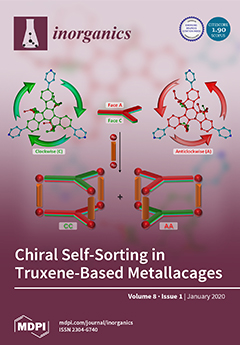A series of [Cu(P^P)(N^N)][PF
6] compounds are reported in which N^N is 2,9-dibromo-1,10-phenanthroline (2,9-Br
2phen), 3,8-dibromo-1,10-phenanthroline (3,8-Br
2phen) or 4,7-dibromo-1,10-phenanthroline (4,7-Br
2phen) and P^P is bis(2-(diphenylphosphano)phenyl)ether (POP) or 4,5-bis(diphenylphosphano)-9,9-dimethylxanthene (xantphos). The compounds were characterized by solution multinuclear NMR spectroscopy,
[...] Read more.
A series of [Cu(P^P)(N^N)][PF
6] compounds are reported in which N^N is 2,9-dibromo-1,10-phenanthroline (2,9-Br
2phen), 3,8-dibromo-1,10-phenanthroline (3,8-Br
2phen) or 4,7-dibromo-1,10-phenanthroline (4,7-Br
2phen) and P^P is bis(2-(diphenylphosphano)phenyl)ether (POP) or 4,5-bis(diphenylphosphano)-9,9-dimethylxanthene (xantphos). The compounds were characterized by solution multinuclear NMR spectroscopy, mass spectrometry and a single-crystal X-ray analysis. Each compound underwent a partially reversible or irreversible copper-centred oxidation, the highest potential being for 2,9-Br
2phen-containing compounds. In solution, the compounds are weak yellow or orange emitters, whereas powdered samples exhibit yellow emissions with photoluminescence quantum yields of up to 45% for [Cu(xantphos)(2,9-Br
2phen)][PF
6] with an excited state lifetime
τ1/2 = 9.9 μs. Values of
λemmax for [Cu(POP)(2,9-Br
2phen)][PF
6] and [Cu(xantphos)(2,9-Br
2phen)][PF
6] are blue-shifted with respect to compounds with the 3,8-and 4,7-isomers, both in solution and in the solid state.
Full article





